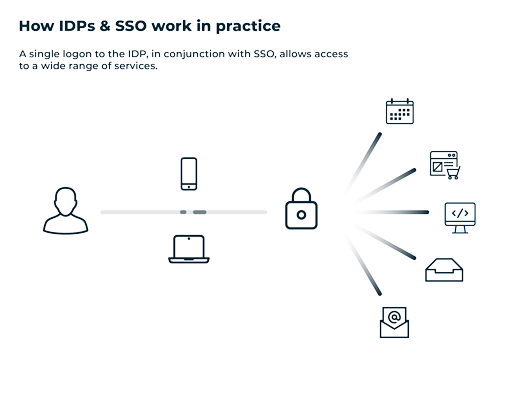Discover how Myra combines digital sovereignty and cyber resilience.
Home>
Identity Provider (IDP)
How does Single Sign-On (SSO) with IDPs work?
IDPs are often used for SSO. Primarily, SSO provides advantages in terms of convenience and security for users. Instead of being confronted with a multitude of different credentials in everyday digital life, the widespread use of SSO dramatically reduces the number of login details required. These limited login details can be better secured with strong passwords and multi-level login procedures. If, on the other hand, users have to manage many different logins themselves, many tend to repeatedly use the same passwords and/or simple passwords – both of which have a negative impact on IT security.
On the technical side, there are also security advantages to using SSO. With SSOs, the authentication factors are only transmitted once. This reduces the attack surface for cyberattacks or phishing attempts aimed at capturing the login data.
What are the solutions for SSO?
Portal
The portal solution allows users to log in centrally to access the various applications and services available via that portal. For example, logging in to an Internet service to use e-mail, calendar, cloud storage and other products. In portal solutions, successful authentication with one service is transferred between all available services via cookies, for example.
Ticketing
Ticketing systems such as Kerberos rely on a trusted authority (Ticket Granting Ticket) for central ticket allocation. Once users have successfully logged in to this authority, further login tickets can be automatically created and sent for each associated service without the need for re-authentication.
Local
Local SSO solutions are mostly used on clients that are accessed regularly in the workplace. Here, the logins for applications and services are centrally and cryptographically protected and stored on the client or a connected network. After successful login on the SSO client, the credentials are activated. SSO clients are integrated in web browsers, for example, as password managers.
Want to learn more about our solutions, use cases and best practices for attack defense? In our download area you will find product sheets, fact sheets, white papers and case studies.
About the author
Stefan Bordel
Senior Editor
About the author
Stefan Bordel has been working as an editor and technical writer at Myra Security since 2020. In this role, he is responsible for creating and maintaining website content, reports, whitepapers, social media content and documentation. This role allows him to bring his extensive experience in IT journalism and technical knowledge to an innovative cyber security company. Stefan previously worked at Ebner Verlag (formerly Neue Mediengesellschaft Ulm) for 7 years and joined the online editorial team at com! professional after working for Telecom Handel. He gained his first journalistic experience during various internships, including at the IT website Chip Online. As a passionate Linux user, he follows the IT scene closely, both privately and professionally.





